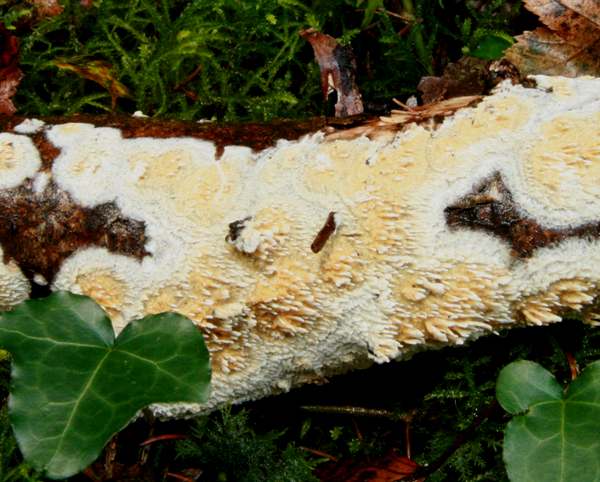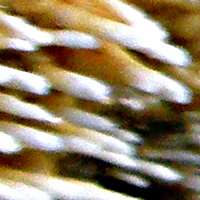Trees Birds Mammals Fish Amphibians Reptiles
Wild Algarve
Bookshop
Basidioradulum radula (Fr.) Nobles - Toothed Crust
Phylum: Basidiomycota - Class: Agaricomycetes - Order: Hymenochaetales - Family: Schizoporaceae
Distribution - Taxonomic History - Etymology - Identification - Culinary Notes - Reference Sources

Neat round fruitbodies of this pale resupinate crust fungus grow and meet to form irregular patches, sometimes covering almost the entire surface of a fallen branch.
This crust fungus consumes dead deciduous hardwood, and it is only an occasional find in most parts of Britain and Ireland.
Toothed Crust is one of the waxy crust fungi that can revive after desiccation.
Distribution
Uncommon but quite widespread in Britain and Ireland, this wood-rotting corticioid (crust) fungus is found also throughout most of mainland Europe.
Taxonomic history
Described in 1818 by the great Swedish mycologist Elias Magnus Fries, who named this crust fungus Hydnum radula (at a time when toothed fungi of various kinds were initially lumped together in a large Hydnum genus, since split up and redistributed across several genera) - the Toothed Crust gained its currently-accepted scientific name in 1967 when Canadian mycologist Mildred Katherine Nobles (1903 - 1993) renamed it Basidioradulum radula.
Common synonyms of Basidioradulum radula include Radulum tomentosum, Sistotrema digitatum Pers., Hydnum radula Fr., Xylodon digitatus (Pers.) Gray, Radulum orbiculare Fr., Sistotrema radula (Fr.) Pers., Radulum corallinum Berk. & Broome, Radulum epileucum Berk. & Broome, Radulum orbiculare var. junquillinum Quél., and Hyphoderma radula (Fr.) Donk.
Etymology
The genus Basidioradulum was established in 1967 by Canadian mycologist Mildred Katherine Nobles (1903 - 1993), and the genus name comes from the prefix Basidio- meaning with basidia (and this corticioid fungus is of course a member of the Basidiomycota). The genus name Radulum (which it sited within the - Class Ascomycota) and also the specific epithet radula in the case of the Toothed Crust may be a reference to the ribbon structure, known as a radula, via which molluscs (other than bivalves) scrape or cut their food before ingesting it. The tooth-like structure of Basidioradulum radula bears a remarkable resemblance to the radulae of some molluscs.
Identification guide
 |
Fruitbody
Patches are rounded at first, ochraceous yellow with creamy-white margins, merging to cover large area; surface wholly or mainly resupinate; fertile surface covered in blunt teeth up to 5mm long. |
| |
Spores
Cylindrical/sausage-shaped, smooth, 9-11 x 3-3.5µm; inamyloid.
Spore print
White. |
Odour/taste |
Not distinctive. |
Habitat & Ecological role |
Saprobic on dead hardwood, mainly fallen branches and felled trunks. |
Season |
Fruiting in late summer, autumn and early winter. |
Similar species |
This is the only Basidioradulum species that is at all common in Britain and Ireland. Two other species in that genus are listed on the British Mycological Society's Checklist of Fungi - Basidioradulum membranaceum and Basidioradulum tuberculatum - but they are extremely rare and have not been recorded in Britain in recent years. |
Culinary Notes
In common with other crust fungi, the Toothed Crust is tough and inedible.
Reference Sources
Fascinated by Fungi, 2nd Edition, Pat O'Reilly 2016, reprinted by Coch-y-bonddu Books in 2022.
Nobles M K (1967). "Conspecifity of Basidioradulum (Radula) radula and Corticium hydnans". Mycologia 59 (2): 192–211.
Dictionary of the Fungi; Paul M. Kirk, Paul F. Cannon, David W. Minter and J. A. Stalpers; CABI, 2008
Taxonomic history and synonym information on these pages is drawn from many sources but in particular from the British Mycological Society's GB Checklist of Fungi.
Top of page...
Fascinated by Fungi. Back by popular demand, Pat O'Reilly's best-selling 450-page hardback book is available now. The latest second edition was republished with a sparkling new cover design in September 2022 by Coch-y-Bonddu Books. Full details and copies are available from the publisher's online bookshop...